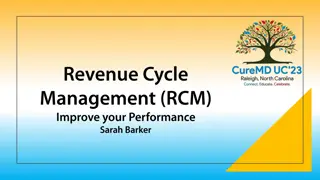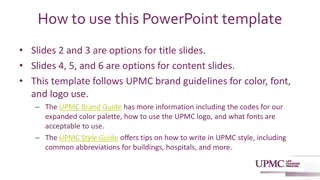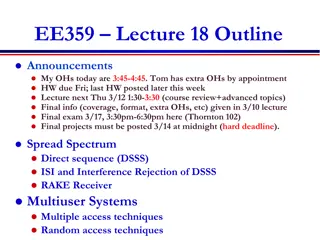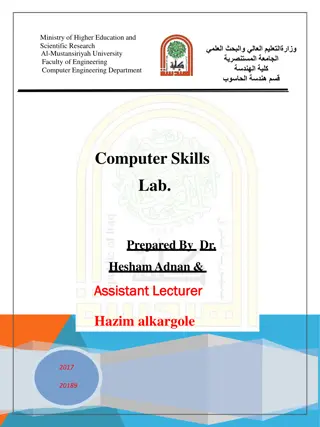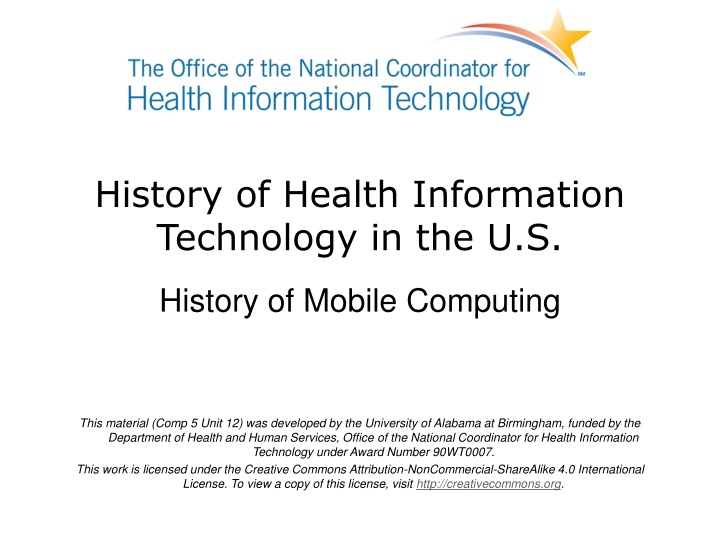
Evolution of Mobile Computing in Healthcare Settings
Explore the history and advancements in mobile computing for healthcare, including the miniaturization of electronics, growth in mobile device usage, and software applications. Learn about the benefits and applications of using mobile computers in clinical settings.
Download Presentation

Please find below an Image/Link to download the presentation.
The content on the website is provided AS IS for your information and personal use only. It may not be sold, licensed, or shared on other websites without obtaining consent from the author. If you encounter any issues during the download, it is possible that the publisher has removed the file from their server.
You are allowed to download the files provided on this website for personal or commercial use, subject to the condition that they are used lawfully. All files are the property of their respective owners.
The content on the website is provided AS IS for your information and personal use only. It may not be sold, licensed, or shared on other websites without obtaining consent from the author.
E N D
Presentation Transcript
History of Health Information Technology in the U.S. History of Mobile Computing This material (Comp 5 Unit 12) was developed by the University of Alabama at Birmingham, funded by the Department of Health and Human Services, Office of the National Coordinator for Health Information Technology under Award Number 90WT0007. This work is licensed under the Creative Commons Attribution-NonCommercial-ShareAlike 4.0 International License. To view a copy of this license, visit http://creativecommons.org.
History of Mobile Computing Learning Objectives Discuss the developments in mobile computing that have enabled portable computers to be used in healthcare settings List the benefits of using mobile computers in the clinical setting, and discuss how these benefits have developed over time Give examples of three applications for mobile computers in healthcare 2
Miniaturization of Electronics Cell phones GPS units Personal music players Televisions Laptops 3
Miniaturization of Computers Easier to use in the healthcare setting 4
Growth in Use of Mobile Devices 1993: Apple launched the Newton Message Pad Photo by P. Christopher Staecker 6
Growth in Use of Mobile Devices 2 1993: Apple launched the Newton Message Pad 2002 to 2008: 17.8% annual increase in mobile devices being sold Source: ( Worldwide PDA , 2008) 7
Growth in Use of Mobile Devices 3 2008: 17 million mobile devices sold Source : ( Worldwide PDA, 2008) 8
Software for Mobile Devices Drug reference 9
Software for Mobile Devices 2 Medical reference 10
Software for Mobile Devices 3 Medical calculators 11
Software for Mobile Devices 4 Patient data (documentation and lookup) 12
Software for Mobile Devices 5 Coding and billing 13
Software for Mobile Devices 6 Calendar functions 14
Software for Mobile Devices 7 Electronic prescribing 15
Mobile Devices in Medicine 1995: ~90% of physicians say they would consider carrying a mobile device Source: (Ebell, et al., 1997) 16
Mobile Devices in Medicine 2 Physician users 1999: 15% 2001: 26% o But higher rate among internists (47%) o Even higher among residents (75%) Sources: (Taylor & Leitman, 2001, ACP-ASIM, 2001, Barrett, et al., 2004) 17
Mobile Devices in Medicine 3 2005: 37% Source: (Menachemi & Brooks, 2006) 18
Drawbacks of Early Devices Early mobile computers Slow processors Little memory Short battery life Poor handwriting recognition made data entry difficult 19
Modern Devices Photo by Yutaka Tsutano 20
Benefits of Using Mobile Devices Cost savings Source: (Lu et al., 2003) 21
Benefits of Using Mobile Devices 2 Education effectiveness 22
Benefits of Using Mobile Devices 3 Time savings 23
Benefits of Using Mobile Devices 4 Error reduction 24
Benefits of Using Mobile Devices 5 Clinical impact 25
Physician Characteristics What type of doctors traditionally use mobile devices? Young age Source: (Garritty & El Emam, 2006) 26
Physician Characteristics 2 Students and residents Source: (Garritty & El Emam, 2006) Kevin McKidd Online 27
Physician Characteristics 3 No difference by gender Source: (Garritty & El Emam, 2006) 28
Physician Characteristics 4 Primary care specialty Source: (Menachemi, et al., 2006) 29
Physician Characteristics 5 Urban physicians Source: (Carroll & Christakis, 2004) 30
History of Mobile Computing Summary Mobile devices Cheap, easy to use, but also have more security vulnerabilities to loss and theft o Need to be encrypted to prevent unauthorized access From stand alone units to networked computers 31
History of Mobile Computing References References ACP-ASIM survey finds nearly half of US members use handheld computers [Internet]. ACP-ASIM Press Release. 2001 Oct. Available from: www.acponline.org Barrett JR, Strayer SM, Schubart JR. Assessing medical residents usage and perceived needs for personal digital assistants. Int J Med Inform. 2004;73(1):25-34. Carroll AE, Christakis DA. Pediatricians' use of and attitudes about personal digital assistants. Pediatrics. Feb 2004;113(2):238-242. Ebell MH, Gaspar DL, Khurana S. Family physicians preferences for computerized decision-support hardware and software. J Fam Pract. 1997;45(2)137-41. Garritty C, El Emam K. Who's using PDAs? Estimates of PDA use by health care providers: a systematic review of surveys. J Med Internet Res. 2006;8(2):e7. Lu YC, Lee JK, Xiao Y, Sears A, Jacko JA, Charters K. Why don't physicians use their personal digital assistants? AMIA Annu Symp Proc. 2003:405-404. Menachemi N, Brooks RG. EHR and other IT adoption among physicians: results of a large-scale statewide analysis. Journal of Healthcare Information Management. 2006;20(3):79-87. Menachemi N, Perkins R, Van Durme D, Brooks R. Examining the adoption of EHR and PDA use by family physicians in Florida. Informatics in Primary Care. 2006;14(1):1-9. Taylor H, Leitman R. Physicians use of handheld personal computing devices increases from 15% in 1999 to 26% in 2001. Harris Interactive. 2001 Aug 15;1(25):1-4. Worldwide PDA & Smartphone Forecasts Report: 1998-2008. eTForecasts [Internet]. Arlington Heights, IL. Available from: www.etforecasts.com WebCite Cache 32
History of Mobile Computing References 2 Images Slide 6: Staecker, P. Christopher. Newton message pad, Available from: Slide 20: Photo by Indiemon, cell phone, Available from: commons.wikimedia.org Slide 27: Courtesy of Dr. Lee Todd Miller. Available from: www.flickr.com Slide 28: Courtesy of DocPlanner. Available from amazonaws.com Slide 29: Available from wikispaces.com Slides 4, 5, 21, 22, 23, 24, 25, 26, 30: Clip Art, Available from: Microsoft clips online. Used with permission from Microsoft. commons.wikimedia.org 33
History of Health IT in the US History of Mobile Computing This material was developed by the University of Alabama at Birmingham, funded by the Department of Health and Human Services, Office of the National Coordinator for Health Information Technology under Award Number 90WT0007. 34






